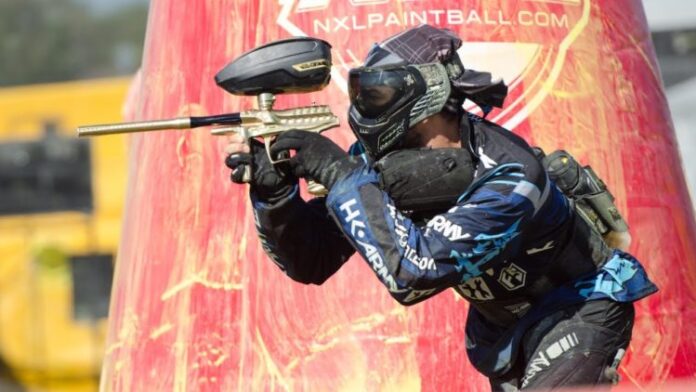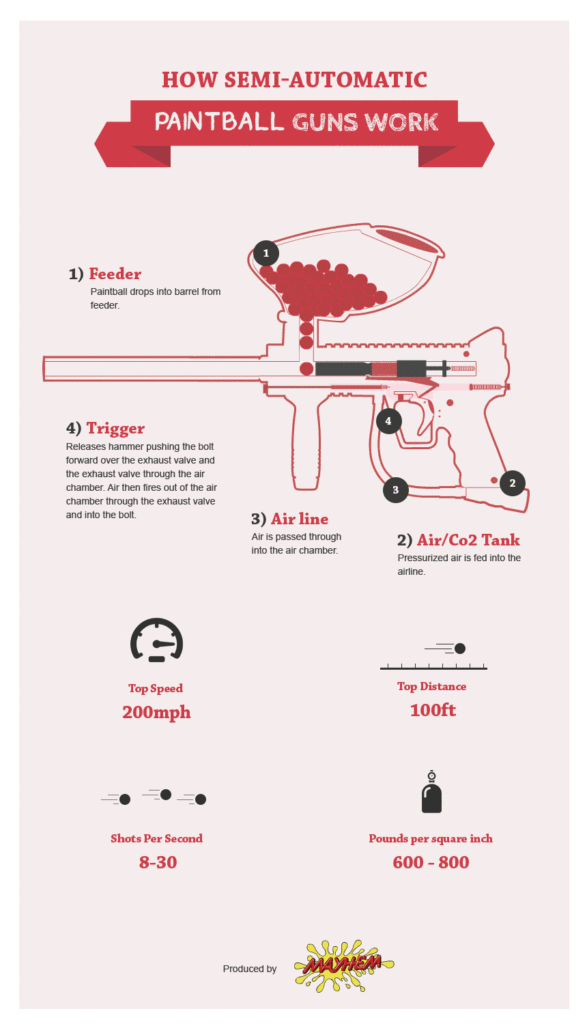
Wanting to use a paintball gun but don’t know where to start?
Don’t worry, below you’re going to learn how to use a paintball gun in just ten simple steps.
As long as you follow all of these ten steps you’ll be a professional paintballer in no time!
Okay, maybe not.. But at least you’ll be able to shoot a paintball gun, and that’s pretty cool right?
How Do Paintball Guns Work?
Before you learn how to use a marker (another term for paintball gun) you may want to first learn how a paintball gun functions. Now you don’t need to know everything that it takes to make a marker operate, but it does help for you to have a general idea of what’s going on.
To keep things simple, a small burst of compressed air or CO2 is released into the marker from an air tank that’s attached to the backside of the marker. The small burst of air or CO2 is then used to propel the paintball(s) out of the barrel at a high velocity.
Here’s a cool infographic that further explains how a paintball gun works from Mayhem Paintball.

While the infographic above explains the functionality of a mechanical paintball gun, there are also electro-pneumatic paintball guns, pump-action paintball guns, mag-fed paintball guns, .50 caliber paintball guns, and even paintball pistols. Each style of paintball gun functions a little differently than the other, but they ultimately all do the same thing – shoot paintballs.
And no matter what type of paintball gun you buy you won’t need to follow all ten rules. Mechanical markers can skip step one and electro-pneumatic markers can skip step five. If there’s no problem with the marker you can also skip step ten as well.
Let’s begin.
Step One: Install the Battery or Batteries
Before you can use an electronic paintball gun you’ll first need to install a battery (or batteries) to turn the marker on. Most electronic markers typically run on a single 9-volt battery, but some of the newer models use AA batteries instead.
If your paintball gun is capable of shooting a high RoF (Rate of Fire) then you’ll also need an electric loader if you want to shoot your maximum bps (balls per second).
Step Two: Attach a CO2 or HPA Tank
The second step you’ll have to take to before you can shoot a paintball gun is to fill a CO2 or HPA (High Pressure Air) tank and attach it into the ASA (Air Source Adaptor) on the bottom of your grip frame.
And while every paintball gun can use compressed air, not every paintball gun can use CO2. In fact, almost all electronic markers require compressed air due to the finicky nature of carbon dioxide (CO2). Mechanical paintball guns, on the other hand, can typically run on CO2 because there’s no solenoid in the marker that can be destroyed by the freezing cold liquid CO2.
But then again, not all mechs can run on CO2 either. For instance, my automag from AGD is a mechanical marker that still requires HPA. I don’t mind though because HPA is better for the internals of your marker and is far more consistent in output pressure than CO2.
Step Three: Load the Hopper
Step three is simple.
Load your hopper with as many paintballs as you can.
If you’re not sure what a hopper or loader is, it’s the “paintball holder” on top of your marker that feeds (or loads) paintballs into the breach of your gun through the use of either gravity or batteries.
Step Four: Pull the Cocking Knob or Press the Power Button
Once you’ve attached an air tank and loader to your paintball gun and made sure that both are filled enough for use then it’s time to turn on your marker.
You can accomplish this by pulling the cocking knob or pressing the power button. The cocking knob (or handle) is typically located on the body frame of most mechanical markers, but it can also be located on top of the body frame as well. On the other hand, the power button is usually located on either the backside of the grip frame or next to the trigger frame.
Step Five: Turn off the Safety
If you’re using a mechanical paintball gun then nine times out of ten there’s going to be a safety button located on the trigger frame. The safety button is used to keep the marker from accidentally firing if the trigger is pulled.
In order to shoot the paintball gun you first have to take your trigger finger and push out the safety button until you see a red line. Once the red line on the safety button is visible then the marker is ready to fire.
The only reason you won’t find a safety button on most electros is because they come equipped with a power button instead.
Step Six: Shoulder the Marker
Once the paintball gun is loaded and you’re ready to fire then you should shoulder the stock or air tank of the marker into your armpit on your dominant side. Your other hand should be used to hold the foregrip of your marker.
Eventually you’ll have to practice off-hand shooting as well. Being able to shoot off-hand is extremely important because it allows you to shoot your marker from the opposite side of a bunker or barricade without leaving your elbow, hopper or shoulder out in the open.
Step Seven: Aim the Marker
If you think aiming a paintball gun is similar to aiming an actual firearm, think again.
While bullets tend to fly straight, paintballs have a habit of flying all over the place. You also won’t be able to rest your face too close to the marker while wearing a safety mask, so you may want to take this into account if you plan on buying/renting one of those fancy woodsball markers with a buttstock like the one below.
So how do you aim a paintball gun?
Lift up the front of your marker with your non-dominant hand until the barrel is pointed towards your target. Then make sure your eyes are placed directly behind and slightly above the backend of your marker. You know you’re in the correct position if the bolt would pop you in the nose if it flew out of the back of the gun.
Depending on the type of paintball gun you use will also determine how you aim your marker.
If your paintball gun has a centerfeed loader then you’ll need to tilt your marker slightly to the side (non-dominant side) so you can look down the barrel and eliminate the loader from being directly in your field of view. However, if you’re using a paintball gun designed for woodsball then should be able to hold your marker without tilting in to one side or the other.
Don’t forget to keep both eyes open as well when you aim to further avoid limiting your field of view. Once again, you’re not using an actual firearm so no need to close one eye at a time.
Step Eight: Pull the Trigger
After you firmly planted the air tank or buttstock into your armpit and aimed your paintball gun towards your target then it’s time to pull the trigger and watch to see where the paintball lands.
If the paintball fails to hit the spot you were aiming for then simply move the barrel in the direction you were trying to hit.
Rinse and repeat until you hit your target.
Step Nine: Adjust the Velocity
In order to ensure the safety of you and all the other players around you then it’s important that you adjust the velocity of your paintball gun to around 280 to 300 fps (feet per second) before stepping foot on a paintball field. Shooting at a velocity higher than 300 fps could possibly lead to an injury or at the very least leave an ugly bruise.
This is one of the most important safety rules in paintball so please take it seriously.
Step Ten: Solve Any Problems
Learning how to use a paintball gun and how a paintball gun operates is great and all, but what do you do if a problem arises and your marker doesn’t perform correctly? Common paintball gun problems include your marker leaking, not firing or turning on, double firing, low velocity, paintballs swerving erratically and excessive breakage.
While I don’t plan on teaching you how to fix these problems, you should be prepared with the appropriate tools if a problem does occur.
